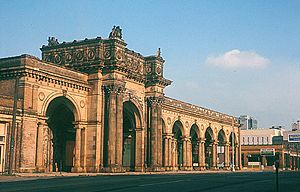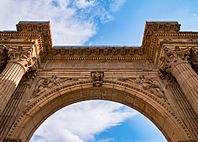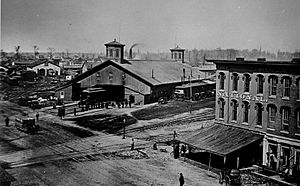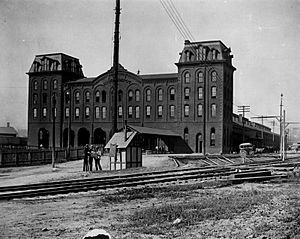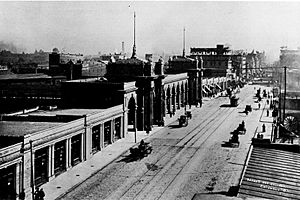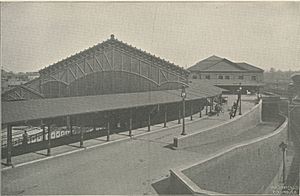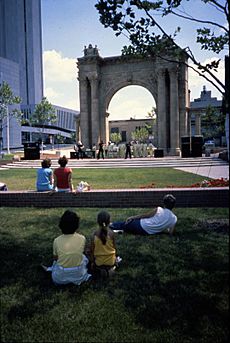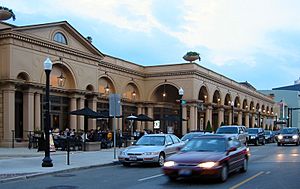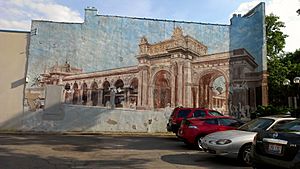Union Station (Columbus, Ohio) facts for kids
Quick facts for kids
Union Station
|
|||||||||||||||||||||||||||||||||||||||||||||||||||||||||||
|---|---|---|---|---|---|---|---|---|---|---|---|---|---|---|---|---|---|---|---|---|---|---|---|---|---|---|---|---|---|---|---|---|---|---|---|---|---|---|---|---|---|---|---|---|---|---|---|---|---|---|---|---|---|---|---|---|---|---|---|
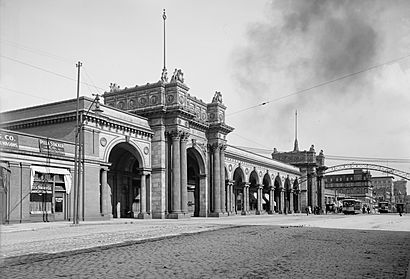
The third Union Station's arcade in the early 20th century
|
|||||||||||||||||||||||||||||||||||||||||||||||||||||||||||
| Location | 370-400 N. High Street, Columbus, Ohio |
||||||||||||||||||||||||||||||||||||||||||||||||||||||||||
| Owned by | City of Columbus | ||||||||||||||||||||||||||||||||||||||||||||||||||||||||||
| History | |||||||||||||||||||||||||||||||||||||||||||||||||||||||||||
| Opened | 1897 | ||||||||||||||||||||||||||||||||||||||||||||||||||||||||||
| Closed | 28 April 1977 | ||||||||||||||||||||||||||||||||||||||||||||||||||||||||||
| Key dates | |||||||||||||||||||||||||||||||||||||||||||||||||||||||||||
| Demolished | October 1976 to September 1979 | ||||||||||||||||||||||||||||||||||||||||||||||||||||||||||
| Former services | |||||||||||||||||||||||||||||||||||||||||||||||||||||||||||
|
|||||||||||||||||||||||||||||||||||||||||||||||||||||||||||
| Interactive map | |||||||||||||||||||||||||||||||||||||||||||||||||||||||||||
| Area | 27 acres (11 ha) | ||||||||||||||||||||||||||||||||||||||||||||||||||||||||||
| Architect | Daniel H. Burnham & Company | ||||||||||||||||||||||||||||||||||||||||||||||||||||||||||
| Architectural style(s) | Beaux-Arts | ||||||||||||||||||||||||||||||||||||||||||||||||||||||||||
| Designated | January 17, 1974 | ||||||||||||||||||||||||||||||||||||||||||||||||||||||||||
| Delisted | 1999 | ||||||||||||||||||||||||||||||||||||||||||||||||||||||||||
| Reference no. | 74002344 | ||||||||||||||||||||||||||||||||||||||||||||||||||||||||||
Columbus Union Station was a big train station in Downtown Columbus, Ohio. It was close to The Short North neighborhood. This station and older ones before it served train passengers in Columbus for many years. It operated from 1851 until April 28, 1977.
The very first station building was special. It was the world's first union station, built in 1851. A new station was built from 1873 to 1875. This happened just before the first one was torn down. Later, traffic problems on High Street and more trains caused issues. So, a famous architect named Daniel Burnham planned a new station in 1893. This new station opened in 1897. Its beautiful archway along High Street was finished in 1899.
By 1928, part of the archway was taken down. Fewer people traveled by train from the 1950s to the 1970s. The main archway was demolished in 1976. This made space for a new convention center. This happened even though it was listed as a historic place two years before. Train service at Union Station stopped in 1977. The rest of the station was torn down in 1979. A piece of the archway was saved. It is now a main feature of the McFerson Commons park. This park is in the nearby Arena District.
Contents
Train Services at Union Station
The first station was run by two railroad companies. These were the Columbus and Xenia Railroad (C&X) and the Cleveland, Columbus and Cincinnati Railroad (CC&C). In 1853, the Central Ohio Railroad and Columbus, Piqua and Indiana Railroads also joined. By 1864, the Steubenville and Indiana Railroad started using the station too.
Many important trains used the station in the 1940s. These included trains from companies like:
- Baltimore and Ohio
- Chesapeake and Ohio
- New York Central
- Norfolk and Western
- Pennsylvania Railroad
An Interurban company also used the station. This was the Cincinnati and Lake Erie Railroad. Interurbans were like electric streetcars that traveled between cities.
Station Design and Features
Daniel Burnham designed Union Station. He was known for his work at the World's Columbian Exposition. This event used a style called Beaux-Arts. It made cities look ideal and beautiful. This style helped start the City Beautiful movement.
Burnham's design made the station very fancy. People in Columbus admired it for many years. However, by the 1970s, as it got older, many people stopped noticing its beauty.
Archway Decorations
The station had two main arched entrances. Each arch was surrounded by four fancy columns. Two angel carvings were placed on the outside of each arch. The arches also had decorative eagle designs. Above these were more detailed carvings and statues.
Smaller arches also had columns. These arches were decorated in a similar way. They reached up to the base of the larger arches' designs.
The ceilings of the arches were curved and covered in plaster. By 1973, this plaster was falling apart. Pigeons made nests in the arches. Moisture was also causing the wood underneath to rot. Stores were located behind the arches. By 1973, most of these stores were empty. Only a cigar shop remained open.
History of Columbus Union Station
The Union Station we remember today was actually the third one in Columbus. The first two were built in the 1800s. New stations were needed because train travel grew very fast in Columbus. After World War II, fewer people traveled by train. This led to the station being torn down. A convention center was built in its place in the early 1980s.
The First Station (1851)
In 1851, two railroad companies bought land. They built a wooden building for passengers. It was 90 by 175 feet. The rest of the land was for shops and freight tracks. This station had three tracks for trains. It was the first union station in the world. A union station is a place where many different railroad companies can use the same station.
More railroads connected to the station in 1853 and 1864. The station became too small. So, in 1868, the railroad companies decided to build a new one.
The Second Station (1875)
Work on the second station began in May 1873. It opened on February 14, 1875. The first station was then torn down. This new station was much stronger. It was made of brick. It had a large waiting room and offices. Seven tracks went into the building. A long roof kept passengers dry. In 1875, 42 passenger trains left the station every day.
High Street Traffic Problems
Columbus kept growing north. Ohio State University opened in 1870. With the new station, thirteen train tracks crossed North High Street. This caused huge traffic jams. Trains blocked the road for many hours each day.
In 1875, a tunnel was built under the tracks. This allowed streetcars and horse-drawn carts to pass. The tunnel was 150 feet long. It was very dark and smelled bad. Only people on the streetcars used it because they had no other choice.
The Third Station (1897)
By 1891, traffic on High Street was a big problem. The road was blocked for up to seven hours a day. The Columbus Board of Trade wanted a modern and grand station. They wanted it to fit their view of the city.
In 1893, a company called Daniel H. Burnham & Company started planning a new station. A key part of the plan was a road bridge over the tracks. This would finally solve the traffic problem on North High Street. In 1893, the old station handled 112 passenger trains every day.
The new station opened in 1897. The archway was finished in 1899. This archway was special to Columbus. It had stores and offices built on top of the bridge. They faced High Street. A raised road connected High Street to the station. The new station had nine tracks instead of seven.
The station's design was inspired by Burnham's work at the Chicago World's Fair in 1893. It used the Beaux-Arts Classicism style. This style was popular for large, important buildings.
In May 1928, part of the archway was torn down. This made more room for cars to get to the station. In 1930, train service moved from another station to Union Station. In 1931, the train shed was replaced with an enclosed area. By 1956, Columbus had only 42 daily passenger trains. This was the lowest number since 1875.
By 1962, only 21 daily passenger trains remained. In 1970, there were just 10. It was clear that cars and highways were ending train travel. On May 1, 1971, Amtrak took over most passenger train service in the U.S. On January 17, 1974, the station's archway was listed as a historic place. This was done quickly because there were plans to tear it down.
Decline and Demolition (1976–1979)

Amtrak reduced train service to just one train. It was the New York-Kansas City National Limited. The station's restaurant and newsstand closed.
The decision to tear down Union Station came from a lawsuit. A group called Battelle Memorial Institute (BMI) was involved. As a result, BMI offered money for various projects. This included $36.5 million to build a convention center at the station's site. BMI created a company to manage this project in 1974.
This company asked for money to build a transit center. It would be part of the convention center. The plan was called TransCenter. It would have transit information, ticket offices, and a bus waiting area. A new bus facility would be built next to the archway.
On October 19, 1976, Battelle decided to tear down the station. They said it was too expensive to keep it. They did not tell other groups beforehand. On October 22, 1976, almost the entire archway was demolished. A court order stopped the demolition the next day. It was secured by the Ohio Historical Society.
Battelle then gave the historical society 120 days to move the last remaining arch. Battelle did not offer money to help. The demolition of the archway caused the government to withdraw $6.24 million in funding. They said it went against the rules.
Even with the archway gone, Union Station served trains until April 28, 1977. Amtrak moved its operations to a small metal shed. This was because running the main station was too costly. The last train left the main station at 9:17 am that morning.
The station was fully torn down in September 1979. The National Limited train service ended a month later. This stopped over 130 years of train service in Columbus.
What's There Now
The old train yards were replaced by a new yard in the 1960s. The many tracks and shop areas later became I-670 in the early 1990s. A bridge over I-670 was built. It has shops along High Street that look like the old archway.
Amtrak has not returned to Columbus since 1977. However, there are plans to build a new multi-use station. It would be located near the Ohio Center and the Greater Columbus Convention Center. A future streetcar or light rail line might also be built there.


